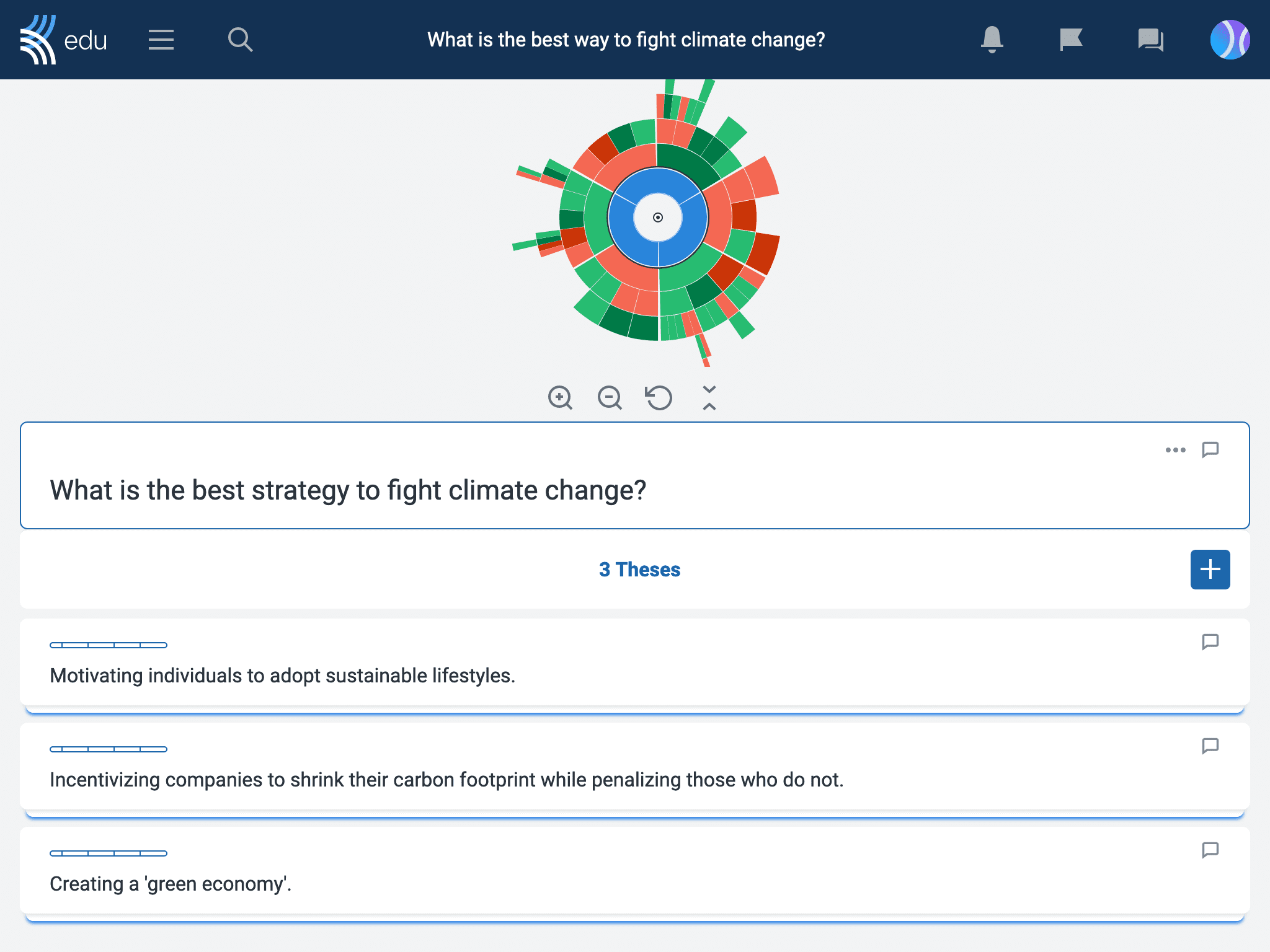Systems thinking is becoming a valuable cognitive skill in our interconnected world, with businesses voting it as one of the top-ten growing skills for employees. Thus, as educators, it’s crucial that we develop our own understanding of systems thinking so we can successfully teach this approach to students and prepare them for academic, personal, and career success.
With this in mind, let’s explore systems thinking in education, examine its many benefits for students, and discover how Kialo Edu discussions can provide a useful framework for systems thinking.
What is systems thinking in education?
Systems thinking is an approach to problem-solving and decision-making that views issues as part of wider, dynamic systems.
Systems thinkers see the big picture — the whole system — when solving problems or making decisions. They evaluate how changes to one part of the system could impact other areas and the system as a whole. This gives systems thinkers a holistic understanding of complex issues, enabling them to make informed decisions and generate effective solutions.
This systems thinking approach is crucial in today’s world where systems surround us. From the energy grid to transportation networks to complex supply chains, systems form the infrastructure of society. The same is true in education, where a network of smaller systems such as assessment, curriculum design, and teacher training contribute to the wider education system.
In education, systems thinking can have an impact in two key ways:
- Stakeholders, such as national education departments and school leaders, can use systems thinking to improve education systems.
- Educators can teach students a systems thinking approach to improve decision-making and problem-solving skills.
Let’s explore each of these in more detail.
Why is systems thinking important for improving education systems?
The problems that arise in complex systems, such as education, are aptly named “wicked problems” because they involve numerous interdependent factors. This makes finding solutions challenging.
For example, implementing an intervention to address attainment gaps would impact staff training, resource allocation, timetabling, assessment methods, and more. Thus, education leaders aiming to improve an educational system can benefit from adopting a systems thinking approach. Evaluating the wider impacts of potential solutions on the whole system enables them to confidently select the most effective option.
What are the benefits of teaching systems thinking to students?
Creating systems thinkers who can address these “wicked problems” begins by teaching students how to use systems thinking in the classroom. And just as altering one component of a system affects other elements, instructing students in systems thinking brings them numerous additional benefits!
1. Students practice better problem-solving and decision-making skills
Systems thinking helps students to develop a holistic approach to problem-solving and decision-making. By viewing a problem as part of a system and examining interdependencies, students learn to look beyond the outcomes of a problem and instead identify its root causes. This deeper understanding leads them to make informed decisions and create effective solutions.
2. Students value multiple perspectives
Systems thinking helps students recognize that every part of a system involves stakeholders with diverse needs, goals, and viewpoints. Teaching students to consider these multiple perspectives helps broaden their thinking and moves them away from narrow solutions.
Instead, students generate inclusive and effective solutions that address the needs of all those involved.
3. Students develop critical thinking skills

Systems thinking requires students to practice critical thinking by analyzing interdependencies within a system. With an understanding of these interconnections, students can evaluate the potential implications of different improvement strategies for every type of situation they come across.
4. Students engage in long-term thinking
Teaching students about feedback loops within systems thinking helps them to develop long-term thinking. Once students understand that the output of any decision they make becomes the input for future operations, they will move away from short-term solutions and instead evaluate the longer-term impacts of their decisions.
5. Students become knowledgeable, active citizens
Real-world systems thinking activities provide students with valuable insights into complex systems in society, including political, economic, and environmental systems. Equipping students with knowledge of these systems builds their civic literacy and can empower them to become active and informed citizens of the future.
How can I teach systems thinking to students?
Open-ended, real-world problems or scenarios provide an ideal context for teaching students to use systems thinking. Here’s an example of how this works in the classroom.
Example systems thinking problem: What is the best way to fight climate change?
Step 1: Identify the parts of the system
Begin by asking students to identify the different parts of the climate change system. This could include energy production, industry, transportation, and agriculture. If students are new to systems thinking, consider narrowing down the number of elements to focus on.
Step 2: Identify interdependencies within the system
Then, guide students to identify the interdependencies between different parts of the climate change system. You could ask them to draw a web to represent this visually. Or, for a more active approach, have some students hold a card to represent a different part of the system, while other students link them together with string to show the interdependencies.
Step 3: Analyze potential solutions
Next, ask students to investigate the different ways to fight climate change. Make this manageable by allocating teams of students different areas to investigate.
Students should use the interdependence webs they created in step 2 to analyze potential impacts of their option on other areas of the system. For example, improving the renewable energy infrastructure could impact agricultural land use, which may impact food production.

Encourage students to develop long-term thinking by having them explore feedback loops, for example by investigating the effect of a temperature increase. Graphics organizers like flowcharts or argument maps can help students to reason through potential impacts.
Step 4: Draw an informed conclusion
Finally, ask students to use their research to draw an informed conclusion to present to the rest of the class. Different groups may draw different conclusions. Teach students that this is acceptable provided that they can justify their decision based on their systems thinking approach.
How to support systems thinking in the classroom with Kialo Edu
Kialo discussions provide an engaging way to develop your students’ systems thinking skills. Our Topic Library contains discussions that are ideal for engaging students in real-world problem-solving scenarios. For example, students can investigate the best source of renewable energy or the best method of transport in a city.
You can even create a discussion question to match your current topic, and guide students’ research by adding your own top-level claims.
Each discussion is framed around an argument-mapping structure that provides students with a visual framework for systems thinking. The branching claims in the discussion prompt students to work through the pros and cons of different ideas. And it’s easy for students to link claims to other claims, helping them to demonstrate interdependencies.
Importantly, there is no limit to this branching system, giving students the space to delve deeply into the topic. Plus, being able to see a representation of the whole system facilitates students in evaluating the wider impact of their suggestions.
Our exploration of systems thinking shows why businesses rate it as an important future skill. But systems thinking in education is not just about preparing students for the future. By teaching students a systems thinking approach, you can equip them with a range of important skills that will have immediate benefits in your classroom!
We’d love to hear your ideas for teaching systems thinking to students. Contact us at feedback@kialo-edu.com or on social media.

